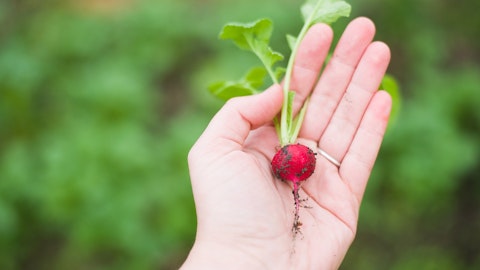Amit Dayal: Right. No, I get it. And we saw that in the financial testing already.
Eric McAfee: Yes, we paid $50.2 million of debt on this one.
Amit Dayal: Yes. On the India Biodiesel capacity ramp 200 million. How much investment is needed? And will the cash flows from that operation basically fund that expansion?
Eric McAfee: It’s a good question. It is going to be funded from India. We do have cash flow, certainly, under this cost plus contract that will largely fund all the activities needed to do it. We will probably incur a small amount of debt near the end of the year, but that will be paid off in 2025. So, the reality is it’s just going to all be paid by cash flow in India.
Amit Dayal: And then how does that set you up, so you previously said you might monetize that asset in some fashion. So now that the facility is operating sort of more regular fashion. Are you considering some of those options you had previously highlighted?
Eric McAfee: We are currently hiring at the executive levels in India, so we will be well prepared in 2024 for what I believe is going to be an attractive public market opportunity. The real question for us is whether the Sensex in India is the right market. I personally strongly prefer the Sensex. The structure for companies going public is very, very favorable. So if for some reason that does not appear to be as attractive for whatever market conditions, there are a number of opportunities we have, including, obviously, NASDAQ, but we have other exchanges that are excited about India, and certainly, there’s other places we could do a public offering.
Operator: Our next question is coming from Matthew Blair with TPH.
Matthew Blair: If you could talk a little bit more about the California Ethanol segment? What was EBITDA for that segment in the quarter? It looks like your realized ethanol pricing might have been a little bit softer than expected. Could you talk about the drivers there? And then you’ve poured a fair amount of investment into this plant. Are some of these projects up and running? Or is it really 2024 when we’d expect to see the upside from things like the ZEBREX plant and the solar grid and those sorts of investments?
Eric McAfee: Let’s talk projects first and then we’ll revert back to EBITDA. The decarbonization of this ethanol plant is a new idea for many folks, unless you’re getting a low carbon fuel standard credit, which means you’re building your product in California, pretty much 100% of your product, you don’t really get paid for it. So, many plants benefit from coal fired electricity, for example, just really cheap and many plants were built specifically because they have access to cheap coal fired kind of double electricity. So our projects was move us to renewable electricity, we have a $10 million solar project, which is literally doing the cutovers here in the next couple of weeks. And then we have the tuning process? So we’ll be fully operating in a month and be doing the final adjustments, so we’re looking for an early first quarter full operation of that unit.
We got an $8 million grant from the California Energy Commission to do that decarbonization. But in order to fully utilize that renewable electricity, we need to have systems in the plant that do not run on petroleum natural gas. So the mechanical vapor recompression concept, which is widely used in industry, specifically in the dairy industry, at creameries. Recompresses your steam by using large electric fans like the power plants to force the air into higher pressure, which increases its temperature, so recompressing using electricity means that we can significantly reduce literally by 80% our petroleum natural gas use it comes from very carbon intensive energy source? That decarbonization will not fully be in place until we have implemented our MVR, Which is currently structured to be at the end of 2024.
So we’re upgrading the energy sources. That’s solar, that’s online literally next month and tweaked and fully sold acceptance for Q1. And then we want to use that renewable electricity to actually change the physical processes in the plant with mechanical vapor recompression. The MVR economics generate in excess of $1 million a month of improved margin by saving us today about 800,000 a month in natural gas and then through lower carbon ethanol, generating almost an equivalent amount of increased ethanol value. So after the increased cost of electricity is subtracted, it’s a $15 million per year increase in cash flow at the ethanol plant. We have some other things that are smaller, the artificial intelligence system and some other things that are just optimizing what we’re doing.
So our overall initiative here though is reduced costs, increased revenue and in so doing, be able to pretty consistently generate $2 million a month, even if all of our competitors are breaking even, we’re still making $2 million a month.
Matthew Blair: And do you have the EBITDA for that segment in the quarter?
Eric McAfee: It was roughly breakeven. This was the start up. This was the completion of our start up though we ended up positive cash flow on a monthly basis, near the end of the quarter. We’re at the — going into the quarter, we’re still doing the start up.
Matthew Blair: And then my follow-up is on, you mentioned the LCFS pathway delays that you’re experiencing. And just wanted to see, is that something that’s unique to the complexity in low CI of dairy RNG? Or is that something that’s affecting everyone across the board? And is your best guess now that you’d receive that pathway by Q2 ’24, and that’s when you start to show EBITDA for the dairy RNG segment?



